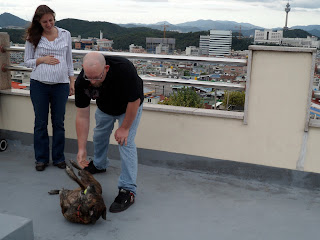Since we came back from Japan, I have
been dividing my time between working, working my way through the
refrigerator, scandalizing old ladies by walking around with my dog
and large belly, and mincing to the bathroom every thirty minutes.
I have learned some new things about
Korean birth traditions. Apparently, we are supposed to stay in the
house for three weeks. To discourage people from coming in, we mark
our door with charcoal. Charcoal also means it's a boy. This is all
meant to discourage germ-bringers from endangering our newborn,
something I support. Since we don't plan to keep the baby inside,
we're going to have to learn how to be rude quickly. You see, old
Korean ladies are fascinated with babies. I have spoken to American
moms who have come to the terrifying realization that their children
are no longer with them in a public place, only to discover that some
older Korean lady has picked them up out of the stroller. I
swallowed my horror when my sweet, well meaning intern told me that
he can't wait to hug my baby, demonstrating a very wrong way to hold
a newborn. Our mantra during those first few weeks will be, “it's
our right to tell people not to touch the baby!” And by the way,
it's rude to touch someone else's baby without asking. I don't care
what culture or background you come from.
We went to a spectacularly bad baby
care class. It was run by a scolding social worker, whose demeanor
was probably not improved by jet lag. She taught us not to shake the
baby, not to put the baby in the shower, and not to use diaper wipes
in the house because they are not economical. I guess she didn't
bother to look at her audience, since we were all late 20's-early
30's and of decent enough rank to afford diaper wipes, as well as old
enough have a basic understanding of the difference between a newborn
and, say, a doll. She had us all look at our different colored
practice dolls and ruminate about where they came from, since
American babies can be all different colors. She told us that
swaddling was out of style and we should cover the baby with a loose
blanket (!) instead. If you don't understand why that's horrid,
google SIDs. One of my favorite quotes was, “Don't sleep with your
baby because you could roll over and suffocate her. Then you will be
accused of child abuse.” The threat of criminal charges are, of
course, far more of a deterrent than the prospect of killing our
children. I couldn't help thinking that this was a baby class
designed for juvenile delinquents.
Never to worry, though, since we live
in the year 2011. There is a wealth of authoritative how-to videos
on the web for those of us who have never changed a diaper or bathed
a newborn. We will be practicing on our new baby doll, purchased so
that we can introduce the dog to the idea of a baby. Yes, we're
total flakes.
 |
| Us on the roof with chicken dog. She spends a lot of time cowering because of the wind. |








































